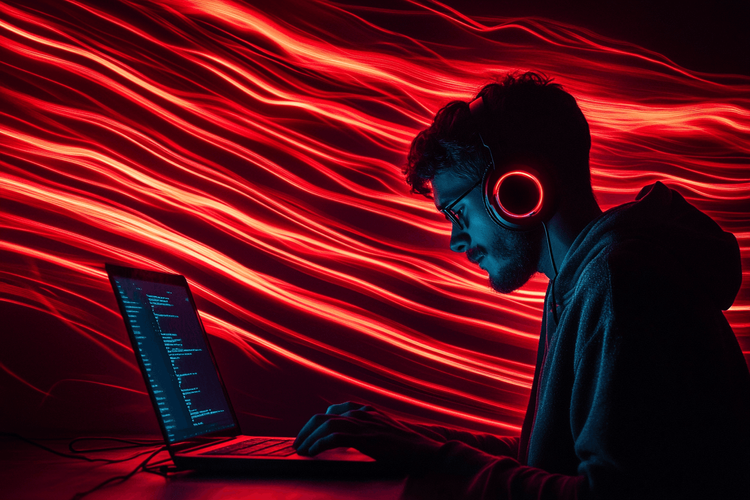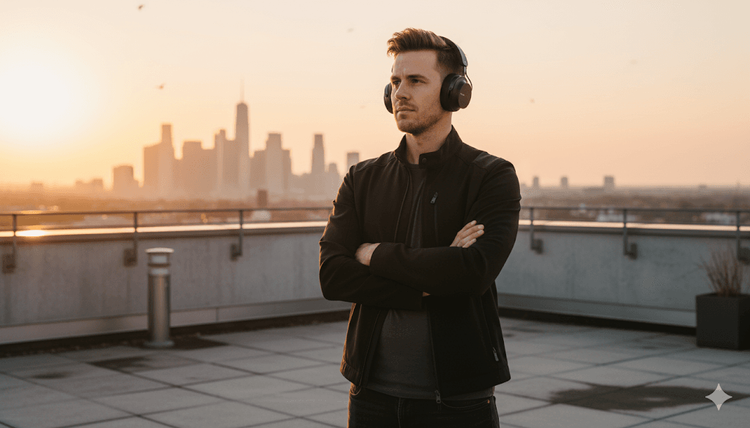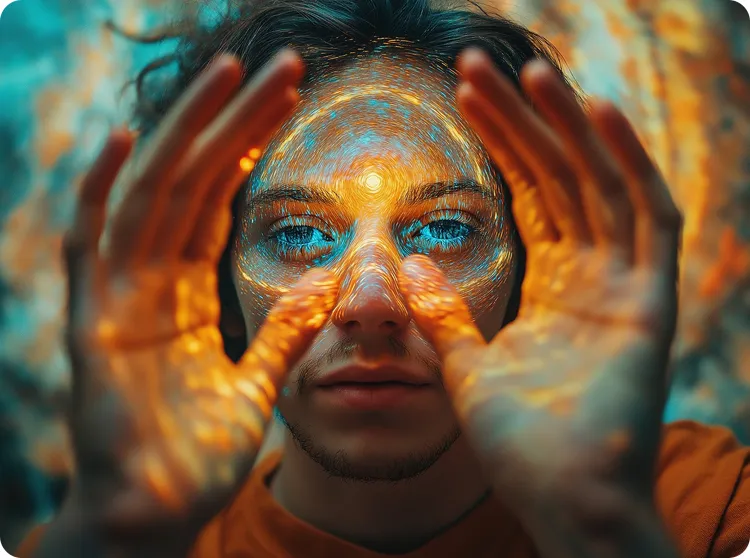There are days when you glance at the clock like you're a long-term creepy stalker. You look up every 30 minutes, only to realise it’s been 30 seconds.
Time drags on infinitesimally. Those days are draining.
But then there are days when you slip on your smart headphones, start a task, and suddenly it’s 6 PM. You’ve barely blinked. You weren’t distracted, you weren’t bored, you were just in it. Locked in. Unfazed. Untouchable.
It’s like that moment in a movie (we're sure you've all seen it once). The one where someone’s completely immersed in what they’re doing - headphones on, lost in a sketch or spreadsheet, while absolute chaos brews around them? People fighting, alarms blaring, prison breaks happening. And they don’t seem to notice a thing.
That’s flow state, in simple words.
And no, you don’t have to wait for random sparks of inspiration to feel it. You can actually train your brain to achieve flow state more often - with the right mindset, environment, and habits.
What is flow state?
In simple words, it's the first paragraph.
In better understanding words, it's this one.
Flow state is when you’re so absorbed in an activity that the entire world seems to fade out.
You’ve probably entered the flow state mindset mid-way through a creative sprint, deep into a work project, or even while catching up with an old friend, where hours pass without you noticing (in the best way). No stressing over your to-do list, no overthinking the “what am I going to do with my life?” thoughts. Just pure, present-moment focus and concentration.
Psychologist Mihaly Csikszentmihalyi (just Google the pronunciation) coined the term. He described flow as the mental zone where you're fully immersed, intensely focused, and strangely calm. It's that “in the zone” feeling - where your brain is challenged just enough to keep things exciting, but not so much that you’re overwhelmed.
When you’re in flow state, distractions lose their grip. You're not tempted to check every Instagram notification or get sidetracked by minor annoyances. You’re just there, present, sharp, and actually enjoying what you're doing.
And the best part? When you finally come up for air, it’s not with that “how is it 5 PM already?!” panic. It’s with a sense of achievement, like, “I got a lot done today.”
The Science Behind Flow
So, what’s actually happening in your brain when you're in flow? 'Cause it feels like literal magic, and honestly, it might be.
When you're in flow, your brain is basically working at its best. It's found the perfectly matched conditions to function. It's balanced. It's zen. It's 'unagi'.
But how?
Reward + Focus = Flow
Two neurotransmitters do the heavy lifting: dopamine and norepinephrine.
Dopamine is everyone's favourite fancy word. Because apparently everyone on the internet is a neuroscientist, and according to the internet, the reason anyone does anything is to get a dopamine hit.
... Well, the second point may be partially correct.
Dopamine keeps you motivated. It's the little “well done” signal your brain sends when you complete tasks - even tiny ones like ticking off a to-do or watching a quick reel. It's rewarding, and that keeps you going.
Norepinephrine, on the other hand, is about attention. It helps you block out distractions and stay sharp, even when things are chaotic around you. So, anytime you're in flow state and barely register a heated argument breaking out between two of your colleagues? (kudos, by the way - we know we could never). That's norepinephrine working so hard for you.
Together, these two play a hand in creating the ideal conditions for achieving flow state and sustaining focus.
But that's not all!
Flow Calms the Overthinking Brain
Being in flow state decreases activity in your prefrontal cortex - that’s the part responsible for shooting up your anxiety, self-criticism, stress and a lot of great functions as well like - planning, problem-solving, decision-making and more.
When it relaxes, overthinking fades, and you’re fully present.
It’s like your brain says, "Hey, we’re -"
And silence. Just you and the task in front of you.
'Brainwaves' become brainwaaaves:
Normally, stress and ‘Beta’ brainwaves go hand-in-hand, keeping your mind on high alert. But in flow, your brain shifts into ‘Alpha-Theta Bridge’ - a calm yet alert frequency of brainwaves. It’s like being in motion and meditation at the same time.
This combination of motivation, concentration, and calm is what makes flow so powerful, and why it’s worth learning to tap into
Why ‘Flow’ Matters in Daily Life
Let’s be honest - most productivity hacks feel more like chores. “Wake up at 5 AM.” “Cut out all sugar.” “Block your calendar in 15-minute slots.” Tedious.
What if the real hack is just… getting in the zone?
That’s where the benefits of flow state really shine.
When you’re in flow, you're not switching between 12 tabs, wondering why nothing's getting done. You're in the moment but also in a trance, and somehow, you’ve written that 3-page report or deep-cleaned your kitchen without checking the time once. Studies show that people in flow can be up to five times more productive. That’s not a win - that’s a victory.
In fact, flow state and creativity have a very close relationship. When you’re dialled in, you’re more flexible and creative with your thinking and problem solving -- allowing you to come up with creative, groundbreaking ideas. (I mean, Facebook was born from a flow state - what else could "wired in" in The Social Network possibly mean?).
So yes, flow is a state of mind. But it’s also one of the most underrated productivity hacks out there. It basically promotes hustle (of a kind) and reduces burnout. Talk about a win-win.
Suggested Read: They designed your screens to ensure you fall behind. It's working.
How to Enter Flow State?

It would be shocking right now if you’re reading this blog and not yelling: “Okay, but how to reach flow state on command?!”
Good news? It’s not a mystery or a once-in-a-blue-moon phenomenon. Here are some real-life-tested tips to get into flow
Clarity + Feedback = Faster flow.
If there's one way to kickstart flow, it's this: get specific.
Without a clear target, your brain flounders. It’s like telling someone, “Just go somewhere!”.
But when you define exactly what “done” looks like - write 500 words, design a new landing page, edit 20 photos - your focus naturally sharpens. You stop spinning around in circles and start moving forward -- becoming more productive.
And when you pair that clarity with instant feedback? Even better. As simple as adding a satisfying checkmark on a to-do list sends small signals to your brain’s reward system -- it keeps momentum building, improves your ability to reach flow state quicker, and concentrate.
Challenge ⚖️ Skill
Flow is plotted in the space between boredom and burnout.
If something feels too easy, your mind wanders. Too hard? You shut down. But when a task pushes you just enough - slightly beyond your comfort zone - that’s when things click.
No need to white-knuckle your way through it. Flow isn’t about struggle, it’s about staying challenged just enough to stay engaged.
Minimise Distractions
Holding on to the flow state mindset requires attention. And attention doesn’t stand a chance against 200 open tabs or your phone buzzing every 2 seconds.
The fix? Create fewer openings for your focus to leak.
Try this:
- Put your phone in a drawer or another room
- Use site blockers
- Try noise-cancelling headphones
- Start with physical clarity before mental.
Use Music, Rituals, and Tools to Signal Focus
Y'know how athletes have pre-game rituals? Entering, holding on to, or even flow state improvement works the same way.
The brain loves consistency. Repeating the same routine, no matter how small, can help switch your mind into a productive and creative mode. That might mean:
- Making coffee before starting
- Playing the same lo-fi ‘focus playlist’ you’ve curated
- Lighting a specific candle
- Wearing “work mode” headphones
These cues act like on-switches. Your brain starts to associate them with deep work.
You can also experiment with new age tech like Sychedelic Headphones -- which use sound-based stimulation to help you reach flow faster.
Set yourself up for deep work, and in no time, you won’t need to force flow state and focus - it'll do the heavy lifting on its own.
Barriers to Flow
Flow state blockers can be sneaky.
They're like invisible evil forces that keep you from diving into the zone. They can feel like you just untangled a pair of wired headphones and placed them in your bag, only to have them tangled 10 minutes later.
Multitasking: It's the hero turned villain of our time. It might seem productive, but it’s often the opposite. That bouncing from email to Slack to a spreadsheet and back again? It drains your focus. You believe you’re staying on top of everything, but your brain never really sinks into one task, and over time, that scatter actually makes you less efficient, not more.
Toooo much stress: Another big culprit. When your mind is overwhelmed by tight deadlines or unread emails, it’s nearly impossible to settle into flow state and concentrate. Instead of clarity, your thoughts spiral. Your focus is hijacked by everything your brain has decided is more urgent.
Noise - both literal and mental: Whether it’s background conversations, someone playing YouTube videos out loud, or that inner monologue telling you you're behind - it all adds up. And even if you slam the door shut, it’s often the mental noise that’s hardest to quiet.
How to Overcome These Flow State Blockers
Mindfulness: It’s all about being present. Mindfulness practices like deep breathing or meditation can help clear your mind of distractions and allow you to enter flow state and focus. The more you practice being in the moment, the easier it becomes to slip into flow when it counts.
Deep Work Techniques: Designed by Cal Newport, deep work involves setting aside uninterrupted time to focus on one task, free from distractions. No notifications, no multitasking. Just you and your work. This creates the perfect environment for flow state and creativity to co-exist, and make your best work happen with ease. Flow isn’t always a random burst of inspiration that shows up when the mood strikes. It’s a skill - one you can build, refine, and come back to over time. With the right environment, mindset, and clarity, it stops feeling like a rare spark and starts feeling more like a switch you know how to flip. And in a world that constantly pulls your attention in every direction. From emails, to messages, to a never-ending stream of tabs -- being able to lock in and focus, and improving productivity and creativity without burning out? That’s a serious advantage.
FAQs
What is flow state in psychology?
Flow is a mental state where you're fully immersed in a task, with deep focus, reduced self-awareness, and a sense of ease. It was first described by psychologist Mihaly Csikszentmihalyi.
Can anyone experience flow?
Yes. Whether you're painting, coding, playing music, or even cleaning—anyone can access flow if the right conditions are met: clear goals, full focus, and a task that’s just challenging enough.
How long does flow last?
It varies. Flow can last anywhere from a few minutes to a few hours. The key is sustained focus—so once you’re distracted, the state can break.
Is flow state the same as being "in the zone"?
Exactly. “In the zone” is just a more casual way of describing flow. Both refer to being fully absorbed in what you’re doing, where time seems to fly.
Can flow be trained?
Absolutely. With consistent practice—like minimising distractions, setting clear goals, and using rituals—your brain learns to enter flow more often and with greater ease.
REFERENCES LINKS
(Flow State: The Brain’s Most Productive State – Humanitas University)
More in Focus


